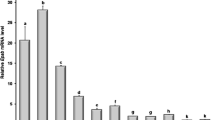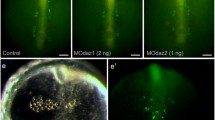Abstract
A maternal protein showing a unique distribution during early Cynops embryogenesis was screened by monoclonal antibody. The antigen protein, designated as ABP-25 (animal blastomere protein, molecular weight 25,000), was distributed uniformly in the uncleaved egg and concentrated into blastomeres of the animal half during cleavage. At the blastula stage, ABP-25 was definitely localized in cells of the animal half and a polarized distribution was observed within the cytoplasm. During gastrulation, immunohistochemical analysis indicated that the reactivity of the marginal zone (presumptive mesoderm) to the monoclonal antibody ABP-25 decreased after involution. At the end of gastrulation, a polarized distribution was still clearly observed in the ventral epidermis, but not in the neuroectoderm. Both Western and Northern blots indicated that the amount of antigen protein and the intensity of gene expresion were almost constant until the neurula stage. The deduced amino acid sequence of the ABP-25 cDNA showed a strong homology (84%) with that of the pag gene associated with cell proliferation.
Similar content being viewed by others
References
Blumberg B, Wright CVE, Robertis EM de, Cho KWY (1991) Organizer-specific homeobox genes in Xenopus laevis embryos. Science 253:194–196
Chae HZ, Kim IH, Kim K, Rhee SG (1993) Cloning, sequencing, and mutation thiol-specific antioxidant gene of Saccharamyces cerevisiae. J Biol Chem 268:16815–16821
Chomozynski P, Sacchi N (1987) Single-step method of RNA isolation by acid guanidium thiocyanate-phenol-chloroform extraction. Anal Biochem 162:156–159
Fleming TP, Johnson MH (1988) From egg to epithelium. Rev Cell Biol 4:459–485
Hainski AM, Moody SA (1992) Xenopus maternal RNAs from a dorsal animal blastomere induce a secondary axis in host embryos. Development 116:347–355
Ishii T, Yamada M, Sato H, Matsue M, Taketani S, Nakayama K, Sugita Y, Bannai S (1993) Cloning and characterization of a 23-kDa stress-induced mouse peritoneal macrophage protein. J Biol Chem 268:18633–18636
Johnson MH, Maro B (1986) Time and space in the early mouse embryo: a cell biological approach to cell diversification. In: Rossant J, Pedersen R (eds) Experimental approaches to mammalian embryonic development. Cambridge University Press, pp 35–65
Kageura H (1990) Spatial distribution of the capacity to initiate a secondary embryo in the 32-cell embryo of Xenopus laevis. Dev Biol 142:432–438
Okada YK, Ichikawa M (1947) Normal table of Triturus pyrrhogaster. Jpn J Exp Morphol 3:1–6
Prosperi MT, Ferbus D, Karczinski I, Goubin G (1993) A human cDNA corresponding to a gene overexpressed during cell proliferation encodes a product sharing homology with amoebic and bacterial proteins. J Biol Chem 268:11050–1156
Sanger F, Nicklen S, Coulson AR (1977) DNA sequencing with chain-terminating inhibitors. Proc Natl Acad Sci USA 74:5463–5467
Smith WC, Harland RM (1992) Expression cloning of noggin, a new dorsalizing factor localizd to the Spemann organizer in Xenopus embryos. Cell 70:829–840
Suzuki AS, Manabe J, Hirakawa A (1991) Dynamic distribution of region-specific maternal protein during oogenesis and early embryogenesis of Xenopus laevis. Roux's Arch Dev Biol 200:213–222
Suzuki AS, Manabe J, Imoh H (1993) Possible mechanisms in the rearrangement of non-yolk cytoplasmic materials during maturation of the Xenopus laevis oocyte. Roux's Arch Dev Biol 202:240–245
Torian BE, Flores BM, Stroeher VL, Hagen FS, Stamm WE (1990) cDNA sequence analysis of 29-kDa cysteine-rich surface antigen of pathogenic Entamoeba histolytica. Proc Natl Acad Sci USA 87:6358–6362
Yamamoto T, Mastui Y, Natori S, Obinata M (1989) Cloning of a housekeeping-type gene (MER5) preferentially expressed in murine erythroleulemia cells. Gene 80:337–343
Yisraeli JK, Sokol S, Melton DA (1990) A two-step model for the localization of maternal mRNA in Xenopus oocytes: Involvement of microtubules and microfilaments in the translocation and anchoring of Vg1 mRNA. Development 108:289–298
Yuge M, Kobayakawa Y, Fujisue M, Yamana K (1990) A cytoplasmic determinant for dorsal axis formation in an early embryo of Xenopus laevis. Development 110:1051–1056
Author information
Authors and Affiliations
Additional information
The nucleotide sequence data reported in this paper will appear in the GSDB, DDBJ, EMBL and NCBI nucleotide sequence databases with the accession number D37808
Rights and permissions
About this article
Cite this article
Tabata, T., Kamio, K., Tajima, T. et al. pag gene-like protein (ABP-25) of the Cynops embryo: regional distribution and gene expression during early embryogenesis. Roux's Arch Dev Biol 204, 400–405 (1995). https://doi.org/10.1007/BF00360485
Received:
Accepted:
Issue Date:
DOI: https://doi.org/10.1007/BF00360485




